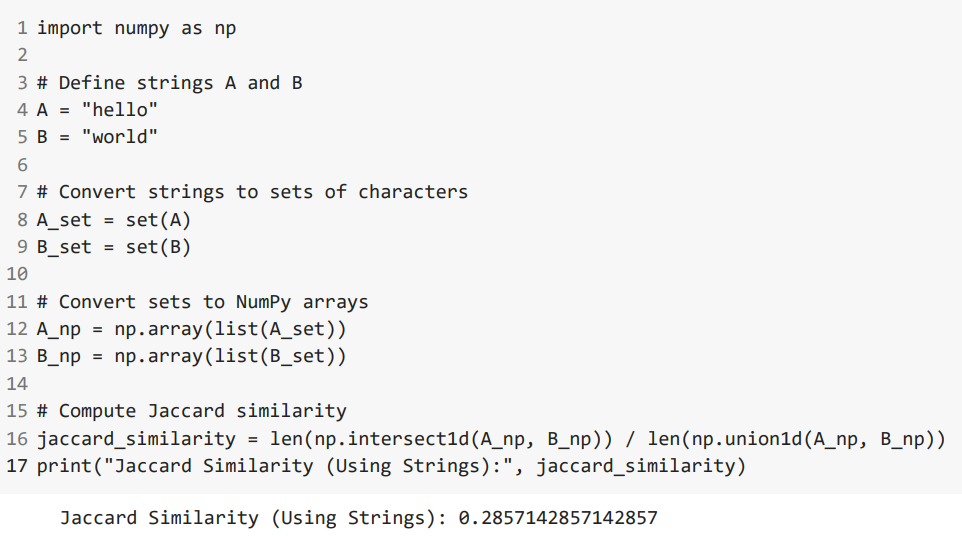Jaccard Similarity in NumPy - What is it and How to Calculate it?
Jaccard Similarity in NumPy: Learn the fundamentals and perform calculations with ease through step-by-step guide. | ProjectPro
The significance of Jaccard similarity lies in its versatility and applicability across various data science projects, including recommendation systems, document clustering, anomaly detection, pattern recognition, and many others. Jaccard Similarity offers a valuable metric for comparing the similarity and dissimilarity between two sets, and it is widely used in various fields, including data science, data mining, and information retrieval. This short guide will help you understand what Jaccard Similarity is and its significance in real-world applications and provide step-by-step guidance on how to implement it using NumPy to make complex calculations intuitive and accessible.
Table of Contents
What is Jaccard Similarity in Python?
Jaccard Similarity is a measure used to compare the similarity and dissimilarity between two sets. In Python, it's often utilized in data science, natural language processing, and machine learning tasks. The formula for Jaccard Similarity is denoted as
J(A,B)=∣A∪B∣/∣A∩B∣
Where -
∣A∩B∣ is the cardinality (size) of the intersection of sets A and B.
A∪B∣ is the cardinality (size) of the union of sets A and B.
Jaccard Similarity is also referred to as the Jaccard index or Jaccard coefficient. Its values range between 0 and 1. A similarity of 0 indicates no similarity between the sets, while a value of 1 signifies that the sets are identical.
Applications of Jaccard Similarity
Jaccard Similarity finds extensive applications across various domains due to its effectiveness in comparing sets without considering the order of elements. Here are some key areas where Jaccard Similarity can be used:
-
Jaccard similarity is employed in natural language processing to compare texts, text samples, or individual words, disregarding their sequence.
-
Jaccard similarity aids in identifying similar items or products based on user behavior patterns to contribute to the effectiveness of recommendation systems.
-
Jaccard similarity facilitates the identification of duplicate or closely similar records within a dataset to streamline the data deduplication processes.
-
Jaccard similarity helps detect similarities between user profiles or groups, enabling insights into community structures and connections.
-
Jaccard similarity is used in genomic studies to compare gene sets, assisting in understanding genetic similarities and differences across organisms.
Step-by-Step Guide on How to Calculate the Jaccard Similarity in Python?
Now, how do you calculate the Jaccard similarity? Here is a step-by-step guide on calculating the Jaccard Similarity in Python to compare the similarity and diversity of sample sets.
Step 1 - Setup the Data
Let's begin by defining two lists, x and y, each containing elements representing sets:
x=['Ram','Shyam','Rohan']
y=['Ram','Rohan','Ganesh']
Step 2 - Defining the Jaccard function
We'll create a function named jaccard to compute the Jaccard similarity between two sets:
def jaccard(x,y):
z=set(x).intersection(set(y))
a=float(len(z))/(len(x)+len(y)-len(z))
return a
This function utilizes the mathematical properties of the Jaccard index to compute the similarity between two sets.
Step 3 - Calling Function and Printing Results
Now, let's call the jaccard function with our lists and print the resulting similarity value:
z=jaccard(x,y)
print(z)
First, call the jaccard function and store the return value in any random variables. Now, simply use the print function to print a new appended dataframe.
Step 4 - Let's look at our dataset now
Upon executing the code snippet above, we'll obtain the Jaccard similarity value:
0.5
For example, we can observe that the area of intersection will be 2 elements, and the area of overlap will be four elements. So jaccard similarity is 2/4 i.e. '0.5'.
NumPy Jaccard Similarity Examples
Here are a few Python code examples demonstrating how to calculate Jaccard Similarity using NumPy:
Example 1 - Calculating Jaccard Similarity Using Sets

Here, we first convert the sets into NumPy arrays to utilize NumPy's array operations. Then, we use np.intersect1d to find the intersection and np.union1d to find the union of the arrays. Finally, we compute the Jaccard similarity by dividing the length of the intersection by the size of the union.
Example 2 - Calculating Jaccard Similarity in NumPy Using Lists

Similarly to the sets example, we convert the lists into NumPy arrays and then compute the Jaccard similarity using array operations.
Example 3 - Calculating Jaccard Similarity in NumPy Using Strings

Here, we first convert the strings into sets of characters to remove duplicates. Then, we convert these sets into NumPy arrays and compute the Jaccard similarity.
Master Jaccard Similarity for Data Comparison with ProjectPro!
This guide has helped you understand the fundamental concepts of Jaccard Similarity and learn how to calculate it using NumPy with the help of practical examples. Understanding this metric allows data scientists and analysts to make informed decisions based on the similarities and differences between data sets, ultimately driving better insights and outcomes. As you delve deeper into your data science journey, ProjectPro offers a vast repository of over 270+ projects centered around data science and big data. With its resources and community support, you can refine your skills and confidently tackle real-world challenges. So, start your journey towards data mastery today with ProjectPro!

